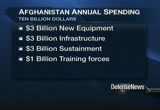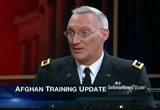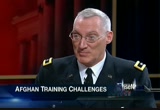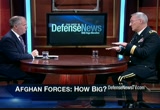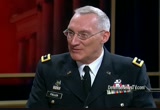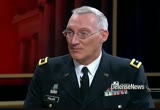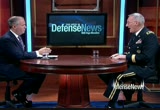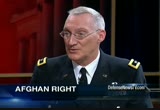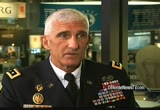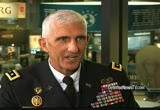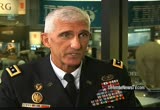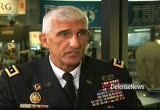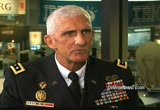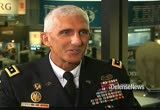tv This Week in Defense CBS October 30, 2011 11:00am-11:30am EDT
11:02 am
welcome to this week in defense news, i'm vago muradian. it's a time for the u.s. troops to come home from europe. the commander of army forces in europe tells us why not. but first, the key to u.s. troops leaving afghanistan by 2014 is the successful training of the afghan army and police. under the current plan, 195,000 afghan army troops and 157,000 police are said to be trained by november 2012. it goes far beyond training troops and supporting logistics as well as building newed buildings. our next guess is in charge of more than $11 billion in annual spending, roughly $3 billion for new equipment, $3 billion more infrastructure, $3 billion
11:03 am
for sustaining forces and $1 billion in training for afghan forces. pete fuller is in town this week for meetings and joins us now. general fuller, welcome to the show. >> thank you for inviting me. >> let's start with that you've got $11 billion in budget. what does that buy in each of the categories and how long is u.s. and nato going to spend this kind of money to train on air forces? >> well, we are at the high water mark fiscal year 2011. next year, we have already identified that we can return back to the federal government, $1.6 billion for the high-water mark that will be the $11.6, it will be $11.2. we're building a force so it is in the boost faze. as you fly an airplane, you need to put in a lot of power to get it off the ground. that's a lot of power. we need to get the recruit at 195,000, putting in $11 billion of infrastructure. i mean we're doing it all at
11:04 am
the same time. we're in the boost faze. once we get it into boost, sustainment is at a lower cost. >> what are the top priorities in each of those things as you are trying to map a future? >> what we're trying to do right now are two elements. one, continue to build the force. by november of 2012, we'll have achieved the 195,000 and 157,000 numbers. then we need to finish fueling the force. we won't stop building it until december of 2013. >> you also have to build the infrastructure. so it's one thing to generate the force. it's the ability for the afghans through their administrative defense to sustain that for it. how do they go through the recruiting process, the precurement process. i'm building a bureaucracy in afghanistan. >> and where are we now in the process of training. what are the figures we're at right now? >> right now the requirement is
11:05 am
195,000, army at 170,000, police, 157,000 and we're at 135,000, 136,000, so we're doing fine. we can sustain it, we are recruiting more than what we are turning down people every month that come in. we are recruiting about 8,000 people a month and we turn down about 1,000 to 1,500. we have high-quality standards required to come into the army and police forces. so we're doing very well on getting to the number of 195,000. >> this is a huge undertaking. if you were doing this in the united states, it would be a big taking. what are some of the challenges you are facing, teaching this kind of comprehensive approach to a country that has not had this comprehensive report from logistics to support the medical and infrastructure? >> reporter: the biggest issue is human capitol. 30 years of civil war, the literacy rate is about 14% in the nation. so we are recruiting from the population. that's one of the biggest
11:06 am
efforts is literacy training in the police force and in the army. i mean, how could you have a professional police force if they cannot read and write and they cannot understand the rule of law. they don't understand how to even write down someone's name or things like that. so we have a huge effort underway to improve literacy. improve professionalism, try to train the non-commission officers, training the officers because it's not just about recruiting people, but about having them here. >> how big ultimately should the forces be? what are the right numbers that are sustainable for them? they are the ones that have to pay for it. >> that is the question we are working through right now. we agree. that is required to do the transition as you talked about. the transition of nato and the international security forces in afghanistan to transition the lead of security in afghanistan. you need it as we see the reduction of the u.s. and the
11:07 am
coalition forces. once you go through that transition period and you go through the national elections, everything else in the 2014 time period, then you need to start looking at how much is the international contribution going to be, how much could the government of afghanistan provide. and then they have to make an informed decision as to do they maintain 152, do they have more police and army or vice versa. and again, they need to look at the conditions in the 2017 time period. >> specifically looking at what their top equipment is, what are the leads from the soldier systems to the vehicles to the intelligence surveillance? >> well, i think that's the action we are working through with the afghans. and they really need to be able to support their own country, and not see the exhibition army nor do they need to have parity with someone on their border. >> right. >> we're not providing them the jet aircraft. they did ask for the f-16s. you can't afford that
11:08 am
capability in the long-term. everything that we're doing, we're looking at it now from the perspective of, well, afghan rights. what's right for afghanistan in the environment where they pay for it and not all of the u.s. national treasure that is used to maintain the capabilities. >> and what about logistics? there is one thing to require all this equipment. another thing to maintain it over a long period of time. what are you doing? they are now the supported backbone for the region and nato? >> yes. well two things, one, we'll talk about building up the force to 352. building these sustaining capabilities, the engineering capabilities, the military signals and logistic signals is the last thing that we're building. so we really need to ensure that we will be able to continue to build that. more importantly as you identify, we have all the trainers out there, so we call them infrastructure and excuse me, i can't remember how to say it anymore. we have all these trainers.
11:09 am
when we build the infrastructure, how do you generate the facility engineers to maintain your own buildings. how do you set up a medical system so we have all these advisors that are there in the medical system, training them how to operate in the operating room, how toking manage patient care, wound care, all these other elements. so we have a lot offedadvisors -- so we have a lot of advisors. the training corporation will be there for a longer period of time where we need to assist them in logistic train, medical training, infrastructure training so they can sustain it themselves. >> right. we'll be right back with more from general pete
11:11 am
we're back with major general pete fuller, the deputy commander of the nato mission to train and equip the afghan police and army. sir, i just want to get into a little more specifics on the afghan equipment and what the needs are. what are they, for example, from the helicopter standpoint. what are their needs from the vehicle standpoint and the general soldier's standpoint? >> sure, let's go through the aviation side first. and they had to previously been trained by the russians, the soviets, and they had m.i. helicopters, for examples, and some others. >> those were the attack helicopters? >> yeah. >> so they had the lift helicopters and also the attack. we are maintaining the say capability and the additional mi-17s. we're not going to buy any new
11:12 am
ones for them. the reason we did that, one, they already had the trained pilots, two, they work very well in that environment. i mean, afghanistan is very unique environment. >> right. >> you talk about the high mountain ranges they need to go through or the past. so the aircraft works very well for their environment. when we talk about this, we're looking at what is right for afghanistan. >> again, the afghan initiative that you're talking about. >> right. what we are trying to do is see how they could sustain and orient. initially we would give them the armor vehicle, calling it the mobile strike force vehicle. initially it was going to have nine configurations, building it off the model of our striker program. and we have now reduced it to two. why do they need all the different configurations. again, it's the human capital. so we're looking at that anywhere we can. giving them the light armored vehicle, actually, we gave them light tactical vehicles initially. they are running around. we also give them the humvees
11:13 am
so they can operate in the environment where they have ied's, etc. we're trying to focus on what the afghan support, what do they need for their country? >> and what about night vision systems? >> night vision, we really limited the amount we're giving them for night vision. they are getting new capabilities for the night vision. and we are, well, again, monitoring that very careful. >> obviously you don't want it to end up in enemy hands. >> of course. we call it afghan like. and if they don't follow the rules, we'll tell them we're not going to continue to feed you and we'll take it back. you have to abide by our rules and regulations especially because again, it's a technology you don't want others to receive because then they could spot u.s. forces. so we are very careful about what we're doing enforcing them to follow their own processes. >> and they are creating that? one is the afghan right and the other is the afghan like and the first. talk to us a little bit about what afghan first hopes to
11:14 am
achieve. >> yes, afghan first, at one point they were going to have a lot of people in their forces. so we are trying to buy the uniforms in afghanistan. we have set up companies in afghanistan, they are afghan companies. and we're working with them to ensure they produce quality product. it's half the price than having it made manufactured in the united states and shipped over to afghanistan. >> and you're employing people in the country? >> yes, and they generate revenue for their own country. we have saved about $36 million by doing what we call afghan first. getting it made in afghanistan. we're going into the infrastructure side of the house, doing it in the uniform and the organizational equipment side of the house. we're doing it anywhere we can, generate one employed afghan to generate revenue for the afghan government. >> let me ask you about the rights. building construction is a very big issue. what does that mean as far as buildings and infrastructures are concerned? >> good question. well, when we went there initially, we started building
11:15 am
buildings that are associated with the western standards. we would give you the individual sinks, western toilets. so the big stand up toilets. we give you all the different things, air-conditioning in all the buildings. then we realized, wow, they wash their feet before they do their prayers. if you give them a porcelain pedestal sink, how do they perch on the edge and do that? and we're ensuring it's right for afghanistan, we gave them trough-type sinks, we gave them the eastern toilets, which is what they are used to. we have done that, and we have put in fans instead of air- conditioning, just putting in fans we see they don't have electrical power so you need generators, which means you need to have fuel. just having the fans, the reduction between $150 million a year in savings. >> and 15 seconds left, are you going to be ready in 2014? >> i think that they will be ready. we're assisting them to get ready. >> all right, thank you very much. we appreciate you. we welcome you back any time. what's next for the u.s. forces in europe? that's coming up.
11:18 am
with the pentagon working overtime to cut more than $450 billion over the coming decade, u.s. bases overseas are coming over increasing scrutiny. some lawmakers argue it's time for u.s. forces to further downsize their footprint in europe to save money. but lieutenant general headquartered in germany argues that maintaining american troops remains important. i caught up with the general earlier this month at the association of the united states army and the annual convention and trade show in washington. i started our talk by asking why the army should maintain 40,000troops in europe more than 65 years after the end of world war ii. >> actually, that's what we're
11:19 am
down to. we originally had a quarter of a million, 213,000 in 1989, we're now down to about 40,000. and they are doing a magnificent job, first of all, continuing to prepare and prevail for the current conflict with our european allies. that's the important determination. they are also helping to train our 51 european partners. the ones that have contributed significantly to that over the last 10 years. early on in the contribution, the allies were not all that good. now, they are fighting above their weight class, alongside our partners in afghanistan, and tired of that arrest. so that's what the u.s. army contributes to the battle. >> and that's one of the services that you have done to sort of bolster the european military capability that has been deployed? >> yes, that's right. >> and every one of those partners we have dealt with, we have seen the huge improvements over the last 8 to 10 years. i could tell you about poland, georgia, romania, bulgaria, even some of the old allies
11:20 am
have improved because they have been fighting alongside us and trained for that fight. >> and is it time for the european bases to be closed and american forces to be pulled out of europe, how much would closing those bases save at the end of the day? >> we had an effort since 2002 to do a u.s. army europe transformation plan. and in fact, outside brac, we consolidated many of our forces going from 850 installations down to about 27 now. we, in fact, save more in europe under our own methods than they did back here about $9.5 billion over that 10-year period. >> because congress did not have to get involved in that process? >> i don't want to go there, but we were very efficient and now i think we have a command structure that's very effective in terms of accomplishing the european commands mission. >> what would happen if you already forced -- if you were forced to withdraw u.s. forces? >> well, i don't want to
11:21 am
speculate on that. i think there's a lot of debate going on in this town about what might happen to the forces, not only in europe, but everywhere. i think there's a lot of political and diplomatic debate still to be had on that. but you know that's for people beside me to determine. whatever happens, we'll adjust our mission as best we can and continue to train our european allies. >> one idea that has been floated is to withdraw permanently forced bases and then have folks deployed through europe. is that a good idea? >> no, it's not. we have done some analysis on that. in fact, we took one of our brigade combat teams. what they do in a 6-month period of time, we determined the cost of exercises that we conduct with about 14 different european countries during that period of time would cost about $400,000 because we're there. to bring forces from the quite on the rotating basis to do the same training would cost about $40 million for those same exercises.
11:22 am
so there's a disconnect between what's being said and what the reality is. >> are folks understanding as somebody who has been generally supportive of u.s. forces being fully deployed, good ambassadors for the country, you also have been engaged on the population in a deeper basis than what folks are being transsent. are there intangibles to having the u.s. forces deployed to europe, that folks aren't really putting into their calendar book? >> yeah, i think so. i use the explosion that every one of our soldier is a diplomat and the acu. the power of the individualsoldier in romania and bulgaria, having been seen by the people in the country is phenomenally important. and the fact that i do engagements as well as my boss does engagements with the european partners, that is a real supplement to the folks in the state department who are doing the same kind of things. we learn a lot, and it is not only good for us as a nation, but it's good for our soldiers
11:23 am
because they understand the kind of cultures they would have to deal with in the battlefield. we have always seen in past wars and past histories that the alliances are tough to keep together. a whole lot tougher if you don't have that. >> and there are some people that say the alliance with germany frayed a little bit as they continued to shrink their footprints in germany. and now they are in contact with americans? >> yes, that is very true. many of my german friends will come to me saying we need to do more engagements with the american soldiers. see more of them training with our armies. and i think that is a pretty solid, you know, statement across the board. and especially with our allies. >> let me take you out here so you have that issue. you have expressed concerns about folks coming back from iraq and afghanistan, having the discipline problems. what are you seeing, how serious is it and what are you doing? >> actually, yeah, i didn't express the concerns about that. we have a small percentage of our population, our soldier as any army in the world does. they don't sometimes do the
11:24 am
right thing. but i was expressing the other day was, you know, the aspect of our profession of arms campaign, after ten years of war, perhaps we ought to, you know, brush off some of the rough, get back to the basic values, get back to our discipline, our fitness in how we build trust. unfortunately there were some that took that as me saying we have a discipline problem in the army. we don't. what we have is a value of requirement to really focus on the things that we do as to who we are as the profession. i think it's time now to, you know, now that we are not focused exclusively on war fighting to really understand what it is to be a professional to be a part of the profession of arms. just because you say you're a professional it doesn't mean you are one. you really have to study, you really have to understand the values of the profession and you have to do the things that are right as part of that profession. that's what i was talking about the other day. >> now, is it an outgrowth a little bit for the folks in the combat zone the entire time that discipline is very different than what it is when
11:25 am
you are here. and that was in an adjustment in some of the troops that they always have coming back home. is that a part of the challenge to sort of reinstill it and say hey look, there's a whole bunch of stuff going on as to how you'll wear your uniform. does that apply when you get back home. >> it's not about wearing the uniform, it's not about doing the right thing. but yes i would suggest when you have a soldier on the battlefield and i have seen instances of this kind of event, where there is a soldier on the battlefield. and he fights well, but he is also somewhat, you know, indisciplined when he is not fighting. and people, they will tend to overlook that because he is such a good fiter. if we bring our army down a little bit, if we make it smaller, the individuals who, you know, the people we need to keep are the ones that could both fight well, but you know, who also understand the values of our profession and do the right thing when no one is looking. that's the important part of all of this. >> all right, thank you very
11:26 am
11:27 am
critics said the exhaust from the marine corp. version of the f-35 fighter would buckle ship decks and its engine noise would deafen soldiers and rupture internal organs. but it misspelled these myths and that the supersonic short take off and landing jet can operate effectively from small deck aircraft carriers. in three weeks on board the area, two f-35b's were conducted and vertical landings to prove that the new plane is easier to fly and maneuver on
11:28 am
and below decks than the harrier jump deck it will replace, facing similar doubts before starting its successful four decade-plus career. the f-35b's success comes as some in washington continue to suggest the marine version of the plane put on probation last year by the then defense secretary, bob gates, should be terminated to save money. but that possession is becoming ever more logical as the jet shows its metal as vital to the strike capability of america's amphibious assault ship. this program surmounts many hurdles, but so far it's proving more capable than its critics have claimed or would like to see. thanks for joining us for this week in defense news, i'm vago muradian. you can watch this program online at defensenewstv.com or e-mail me at vago@defensenews.com. until then, have a great week.
161 Views
IN COLLECTIONS
WUSA (CBS) Television Archive
Television Archive  Television Archive News Search Service
Television Archive News Search Service 
Uploaded by TV Archive on

 Live Music Archive
Live Music Archive Librivox Free Audio
Librivox Free Audio Metropolitan Museum
Metropolitan Museum Cleveland Museum of Art
Cleveland Museum of Art Internet Arcade
Internet Arcade Console Living Room
Console Living Room Books to Borrow
Books to Borrow Open Library
Open Library TV News
TV News Understanding 9/11
Understanding 9/11


